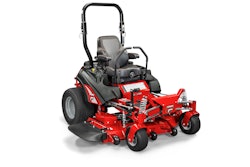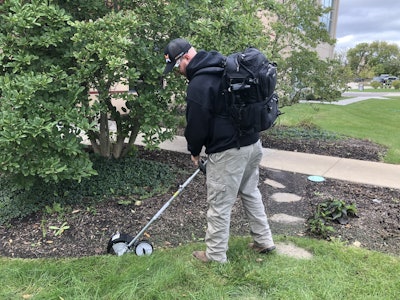 Landscapers in Echo’s user advisory group tested out the new products during the #20for2020 event.
Landscapers in Echo’s user advisory group tested out the new products during the #20for2020 event.Photo: Jill Odom/Total Landscape Care
Last week, Echo invited a group of professional landscapers and the media to its 20 for 2020 press event, where it provided a first glimpse at the 20 new products that will be available next year.
“Launching 20 products in any given year is a big deal,” says Wayne Thomsen, vice president of marketing and product management.
On Oct. 3, attendees got the first sneak peek of the 20 new products, including Echo’s entry into the pressure washer and generator markets.
“I think it was a big surprise on all the new equipment,” says Scott Horoszewski, owner of Landscapes by Acme based in Swanton, Ohio. “All the generators and power washers were a big surprise. I didn’t think they’d go that way. I thought they’d go more battery-powered equipment.”
 Ryan Ladley, vice president of operations, explains poka-yoke mechanisms in the assembly process.
Ryan Ladley, vice president of operations, explains poka-yoke mechanisms in the assembly process.Photo: Jill Odom/Total Landscape Care
On Oct. 4, Echo started things off by giving an insider tour of its manufacturing facility in Lake Zurich, Illinois. The company has been working on more vertical integration and bringing more manufacturing in-house as of late.
Some of the main goals at Echo’s manufacturing facility are to reduce waste and to take care of its people.
“The people make the company,” says Ryan Ladley, vice president of operations, who led the tour. “We want to make sure we make them feel as valued as possible.”
This includes anything from adding padded mats to make standing at stations more comfortable to providing training and mentoring for employees that are not performing up to standard. Echo is constantly working to improve the ergonomics of employees’ workstations. Ladley says they spent $250,000 to add torque arms that made it easier to use certain tools, reducing workers’ comp claims.
Ladley says one of the keys to making sure the training sticks is to follow up afterwards to ensure there is no complacency.
One of the ways the company has cut down on waste is by pad printing on their equipment rather than using labels.
Echo is also always on the lookout for new ways to improve by following the Japanese practice of poka-yoke, which is any mechanism in a process that helps an employee avoid making a mistake. By including these mistake-catching process, Echo is able to contain issues and prevent them from reaching the end user.
“Dig deeper, find something better, never settle,” Ladley says.
After the factory tour, Joe Fahey, vice president of product service and robotics, delved into the new robotic products Echo has to offer. The TM-2000 is the 2nd generation of Echo’s commercial robotic mower and the RP-1200 is a robotic range picker for golf ball collection.
“We believe this is the future,” Fahey says. “It’s been proven in Europe.”
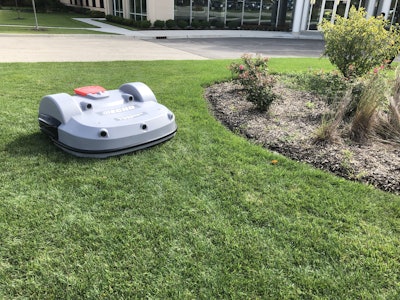 The TM-2000 is the 2nd generation of Echo’s robotic mower.
The TM-2000 is the 2nd generation of Echo’s robotic mower.Photo: Jill Odom/Total Landscape Care
The TM-2000 can mow up to six acres. It is able to mow for two hours before it will return to its charging station, which takes an hour to recharge. The mower has five cutting heads and the height of the cut can be adjusted. The mower is currently being used to maintain Clemson’s rugby field.
Richey Plemons, owner of Plemons Lawn and Landscape based in Chatsworth, Georgia, says he’s seen a lot of pushback from those in the lawn care industry worried that a commercial robotic mower is going to take jobs away, but he sees it as a way to help make up for missing manpower in the field.
“Landscapers just need to give it a shot and be open minded about the robotic mowers, I feel,” Plemons says. “They need to weigh the pros and cons. Yeah, it’s not going to be perfect for every application, so you’re never going to completely take the human element out of the work. It’s never going to happen. It’s always going to have to have a human being making sure the work is done properly and going back in and doing the detail work.”
Jake Vollbeer, national sales manager for robotics, says the TM-2000 has an expected lifespan of five years. The machine uses a magnetometer to detect the buried guidewire, so it stays within a certain property.
“I see a lot of profitability in it once we get the American market to understand there’s no turning back,” says Plemons. “It’s coming to this whether we like it or not.”
As mentioned earlier, Echo has entered two new markets with five generators and five pressure washers.
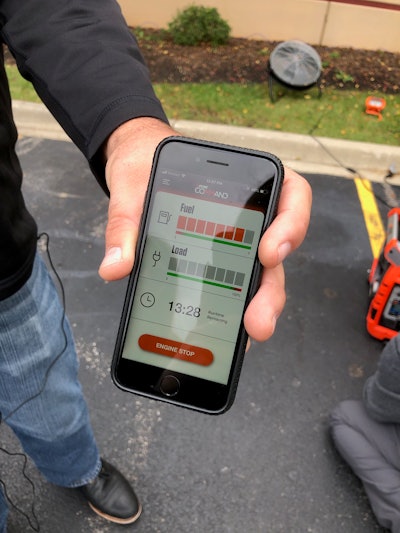 The Echo Command app allows users to remotely turn off their generators and see the load, fuel levels and run time.
The Echo Command app allows users to remotely turn off their generators and see the load, fuel levels and run time.Photo: Jill Odom/Total Landscape Care
The EG-3500 generator has a compact frame, double-folding handle and circuit breaker protection to prevent overloading. The EG-10000 is Echo’s highest power conventional generator and is ideal for remote operations or larger job sites.
Echo also has three inverter generators the EGi-1200, EGi-2300 and EGi-4000. The EGi-4000 is suitable for both professionals and homeowners. It has 70 percent greater maximum wattage than the EGi-2300 and comes equipped with Echo Command, a Bluetooth integration that monitors load, fuel levels and run time. It also comes with Echo COntrol, which senses and alerts users when there are dangerous levels of carbon monoxide.
“Having some of those generators with Bluetooth was a great plus for homeowners and certain businesspeople would enjoy Bluetooth generators,” Horoszewski says. “To be able to see exactly how much power is left in it, how much gas is there, know how much load is on there, that’s one plus for that.”
As for the pressure washers, three of the new models are commercial grade. The PWE-1800 is an electric pressure washer for homeowners, and the PW-3100 was built with homeowners in mind as well.
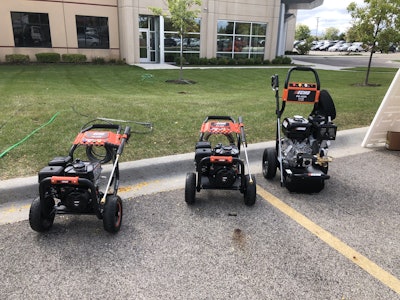 Three of the new pressure washers are commercial-grade.
Three of the new pressure washers are commercial-grade.Photo: Jill Odom/Total Landscape Care
The PW-3200, PW-3600 and PW-4200 are built to have five times longer lifespan compared to the residential models. The PW-3200 has a synthetic rubber hose, while the PW-3600 and PW-4200 have stainless steel hoses.
Another hefty rollout from Echo are its five new hedge trimmer models. The HC-2210 has a 22-inch blade with a 3-position 180-degree rotating handle for increased maneuverability. The HC-2810 has a 28-inch blade. It has a front-facing exhaust that prevents plant damage and pushes exhaust away from the operator.
Both the HCS-2810 and HCS-3810 are single-sided hedge trimmers with 28- and 38-inch blades, respectively. The SHC-2620S has RazorEdge 3-sided teeth for longer cutting performance. Echo points out that its new hedge trimmers are lighter than the competition.
Echo also introduced the SRM-2320T string trimmer, with entry-level commercial landscapers in mind. It has a 17-inch cutting swath and a 21.2 cc engine.
Plemons is particularly excited about the SRM-2320T string trimmer and the SCHC-2620S hedge trimmer.
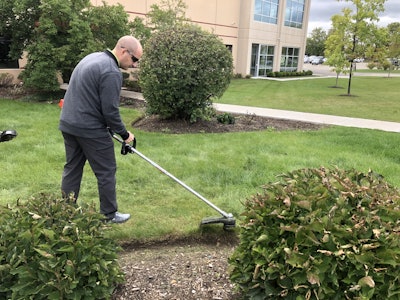 The SRM-2320T string trimmer is marketed toward entry-level landscapers.
The SRM-2320T string trimmer is marketed toward entry-level landscapers.Photo: Jill Odom/Total Landscape Care
“I absolutely loved it,” he says. “I’m in need of some new hedge trimmers and that was right up my alley, and the new 2320T string trimmers. I’m in need of some light-weight everyday maintenance trimmers and those are going to be perfect for my application where we do so many condo associations that get mowed every week.”
Last but not least for the new products, Echo unveiled its two new spreaders, the RB-60 and RB-100W. The RB-60 is a 60 lbs. broadcast spreader while the RB-100W is designed to be a rock salt spreader with a stainless-steel frame for corrosion resistance.
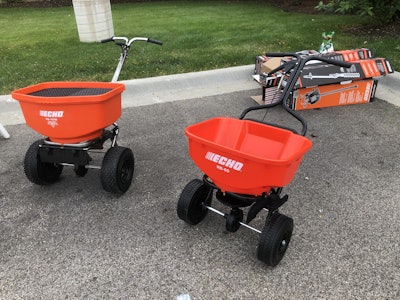 Photo: Jill Odom/Total Landscape Care
Photo: Jill Odom/Total Landscape Care“Having the new spreader for the snow removal is awesome because a lot of companies use spreaders for snow removal,” Horoszewski says. “This will change a lot of people’s perspective of Echo. They’re not just making mowing related equipment. They’re out there providing great equipment for other sources of income.”
While it’s not necessarily a new introduction, Echo did show off its changes to the PB-8010T tube and elbow in response to landscaper feedback.
“The old elbow was kinking up,” Plemons says. “It was very stiff, so 10 minutes into using it, your right arm felt like it was going to fall off and it got heavy and cumbersome over time. So, they went to a more flexible tubing that won’t kink up and it’s much easier to move back and forth now and your arm is not going to get tired. Less fatigue means more energy, which means more production which means more efficiency. That’s something that I was really surprised that they actually listened to us and said, ‘Hey, let’s fix it.’”
“Their (Echo’s) reputation is starting to get bigger,” Horoszewski says. “If you don’t know what they provide, you should definitely check out a dealership and demo it and see how it performs compared to other equipment because there’s a big difference in some things. Echo’s always trying to reconfigure things to make sure everyone is fully happy.”


